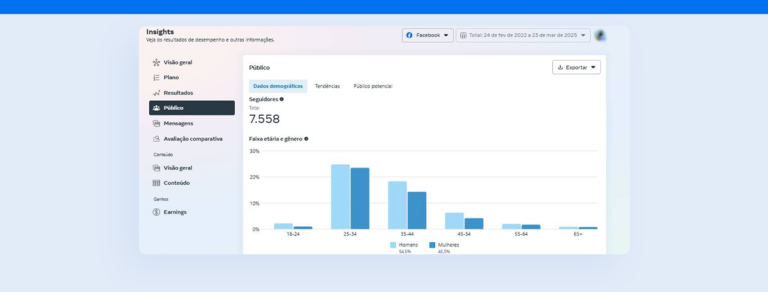Discover what influencer marketing is and get tips for achieving the best results with your partnership campaigns.
Nowadays, influencer marketing is one of the most powerful strategies for reaching target audiences authentically and engagingly. After all, by collaborating with influential individuals on social media, brands can increase their visibility, credibility, and ultimately, their sales.
However, to ensure the success of this approach, it’s crucial not only to select the right influencers but also to present tangible results that demonstrate the return on investment (ROI).
Therefore, in this article, we’ll explore the key strategies for achieving good results from partnerships with digital influencers and how to measure the impact of campaigns. Let’s go?
What is Influencer Marketing?
Influencer marketing is a strategy that involves collaborations between brands and influencers in a specific niche or market segment. These individuals, also known as influencers, have authority, credibility, and a large number of followers on social media platforms, blogs, or other online channels.
Thus, the strategy is based on the idea that consumers are more likely to trust the recommendations and opinions of people they admire and follow. Therefore, by associating their brands with influencers relevant to their audience, companies can increase their visibility, reach, and credibility, as well as boost engagement and sales.
Influencer marketing collaborations can take various forms, from sponsored posts on social media (the famous sponsored post) and unboxing videos to product reviews and event participations.
Regardless of the format, the goal is to create authentic and engaging content that resonates with the influencer’s audience while promoting the products or services more directly and personally.
However, it’s important for brands to select the right influencers, aligned with the organization’s values and with an authentic follower base, to ensure the success of their influencer marketing campaigns.

How to Achieve Good Results in Influencer Marketing?
To achieve good results in influencer marketing, it’s crucial to follow a strategic and well-planned approach. Thus, we’ve selected some tips to succeed in the field:
- Define your goals: before starting any influencer marketing campaign, it’s crucial to be clear about what you want to achieve. Whether it’s increasing brand awareness, boosting the sales of a specific product, or increasing engagement on Instagram or TikTok, set clear and measurable goals to guide your activities;
- Choose the right influencers: assess not only the size of their audience but also relevance to the brand, authenticity, engagement, and values aligned with your company;
- Develop a content strategy: collaborate with influencers to create authentic and engaging content that resonates with their audience and effectively conveys your brand message;
- Establish success metrics: identify the key metrics you will use to measure the performance of your influencer marketing campaign. This may include reach, engagement, conversions, or direct sales, for example;
- Promote transparency: ensure that both you and the influencers you’re collaborating with are transparent about the nature of the partnership. This includes clearly disclosing when content is sponsored or paid for, to maintain public trust;
- Evaluate and continuously adjust: after the campaign ends, analyze the results obtained relative to your initial goals. Identify what worked well and what can be improved, and use this information to inform your future influencer marketing strategies.
By following these tips and adapting them to your brand’s specific needs, you’ll be on the right path to achieving good results in influencer marketing.
What Types of Influencers Exist?
There are various types of influencers, each with distinct characteristics and specific reach. Below, we’ve selected the main classifications:
- Megainfluencers: More than 1 million followers
- Macroinfluencers: Between 500,000 and 1 million followers
- Mid-tier Influencers: Between 100,000 to 500,000 followers
- Microinfluencers: Between 10,000 to 100,000 followers
- Nanoinfluencers: Up to 10,000 followers
- Megainfluencers: These are the most well-known personalities to the general public, boasting over 1 million followers on platforms like TikTok, Twitter, or Instagram. Hence, they are typically hired by large brands;
- Macroinfluencers: They have a large number of followers on their social networks, usually between 500,000 and 1 million. Thus, they have significant reach and can be specialists in a specific niche, such as fashion, beauty, fitness, technology, among others;
- Mid-tier Influencers: Usually embedded in a more defined sector, they can reach an audience of 100 to 500 thousand followers;
- Microinfluencers: Reach a smaller audience, generally ranging from 10 to 100,000 followers on their social networks. Although their reach is smaller compared to the classifications above, they tend to have a more engaged and niche follower base, which can result in higher conversion rates;
- Nanoinfluencers: These are individuals with an even smaller audience, generally up to 10 thousand followers. They are typically experts in extremely specific niches and have a high level of trust and intimacy with their community of followers.
Each type of influencer has its own advantages and is suitable for different campaigns and marketing objectives. Therefore, it’s important for brands to understand the characteristics and reach of each type of influencer when planning their influencer marketing strategies.
How to Choose the Right Influencer for Your Brand
Choosing the right influencer for your brand is a crucial step for the success of an influencer marketing campaign. Check out the main tips to aid in this process:
- Pay attention to your goals: this will help guide your search for the right influencer to increase brand recognition or boost sales, for example;
- Know your audience: understand who your persona is and which influencers they follow and trust. Consider the interests, values, and behaviors of the audience before making a choice;
- Assess relevance and authenticity: look for influencers whose content is relevant to the brand and who have an authentic and genuine voice. Check if the candidate has promoted products or services similar to yours in the past and how the audience received them;
- Analyze engagement and reach: don’t just focus on the number of followers an influencer has, but also on the engagement they generate. Evaluate metrics like likes, comments, shares, and views to get an idea of how engaged the profile’s community is;
- Check content quality: along with this, analyze the type of content the influencer produces and how it aligns with your brand’s image and values. After all, the quality of photos, videos, captions, and other elements ensure professionalism and good execution;
- Evaluate credibility: research the influencer’s reputation and check if there’s any history of inappropriate behavior or controversies that could negatively affect your brand’s perception. Choose influencers who are trustworthy and respected in their respective communities.
By following these tips and conducting careful research, you’ll be better equipped to choose the right influencer to represent your brand and achieve your marketing goals.
How to Evaluate Results?
Finally, it’s worth noting that evaluating the influence report is essential to determine the success of a campaign and identify areas for improvement for future initiatives. Here are some ways to measure your investment return:
- Engagement metrics: analyze likes, comments, shares, and saves on the influencers’ posts. These metrics indicate the level of interest and interaction of the audience with the content;
- Reach: measure how many people were exposed to the content generated by the influencers. This can be done through metrics like impressions, video views, and the total reach of posts;
- Conversion rate: track how many sales, leads, or other desired actions were generated as a direct result of the influencer marketing campaign. This can include the use of exclusive discount codes, tracking links, or other forms of conversion tracking;
- Consumer sentiment: assess consumer feedback regarding the brand after the campaign. This can be done through social media analysis, monitoring brand mentions, and market research to understand public perception;
- ROI (Return on Investment): if possible, calculate the financial return generated by the campaign compared to the initial investment;
- Traffic and conversions analysis on the website: use tools like Google Analytics to track website traffic and conversions during and after the campaign. This will help understand how the influencers’ content impacted the behavior of website visitors;
- Influencer feedback: request feedback from influencers about the campaign, including their experience working with the brand, audience feedback, and suggestions for improvement.
By combining these different metrics and analyses, brands can obtain a comprehensive view of the performance of their influencer marketing campaigns, decide whether they wish to maintain the partnership, and make the best decisions to optimize their strategies in the future.





